Chapter 4. Leading Teams to Win
In this chapter, we look at ways to communicate vision and purpose, and how to align teams achieve success. We explore the mechanics of autonomy with the protocol of coherent action, and introduce some methods that help teams to make decisions and prioritize along the way.
Let’s be honest: a lot of the work that goes on in modern businesses can seem void of meaning. Most of us aren’t providing critical services, saving lives, or curing diseases. Mostly, we’re building software products and services. And mostly, we’re doing it for commercial gain. Maybe not our own individual gain, but at least the gain of our employers, or their shareholders, or capitalism at large. That’s not very motivating. For those with a strong work ethic, hard work is a virtue, but the work in itself isn’t always virtuous. The next generation of talent are set to challenge the status quo of hard work for fair pay further yet, and they’re estimated to comprise 75 percent of the workforce by 2025. Organizations are desperate to find ways to make work more meaningful, purposeful, and engaging for people.
People want to be self-directed, trusted, and empowered to do the right thing. Even in seemingly mundane workplaces like the Faber-Castell pencil factory in Nuremburg,1 people are happier, more engaged, and do right for the company when they’re included and valued as people, not just resources or units of effort. A senior manager at Faber-Castell chalks this up in part to the culture of empowerment at the company.2
The more you give people a say, the more they help the company to win.
Senior manager, Faber-Castell
A highly engaged, purpose-driven, and empowered workforce. Great! But, unless everything is coordinated and aligned, efforts easily become incoherent and potentially counterproductive. Just like the following story of a motivated, passionate, and engaged team that ultimately failed because it’s members cared about different things and were pulling in different directions.
Sometimes it feels as if getting people on the same track is the most difficult thing facing any team. Having a clear direction, getting everybody aligned, and taking coherent action is critical. Let’s look at how to do that.
Purpose-Driven Autonomy
In Drive,4 author Dan Pink makes a compelling case that incentives and bonuses are a bogus mechanism for getting people to perform at their best. In studies of human motivation, he finds that giving incentives leads to poorer performance for tasks that require even just a little cognitive ability.5
Instead he argues that autonomy, mastery, and purpose are key to motivation and engagement:
- Autonomy
- The urge to direct our own lives.
- Mastery
- The desire to get better and better at something that matters.
- Purpose
- The yearning to do what we do, in the service of something larger than ourselves.
Mastery in large part is about passion. You can’t necessarily make someone passionate about something. That’s intrinsic. But we can do things to make work more purposeful, and create an environment in which teams and individuals have autonomy to do their best work.
We can communicate purpose in our vision. We can include everyone when defining desired outcomes. And, we can give teams autonomy and accountability to determine their own strategy.
Perhaps nowhere else is this so critical, as it is in military operations. Armed forces have formalized their guide to action as military doctrine. Let’s look at what we can learn from how they run operations.
Mission Command
Warfare is unpredictable and dynamic. Information is incomplete and situations unfold quickly. Agility and adaptation are critical to success and survival.
The Army Doctrine on Mission Command (ADRP 6-0)6 is fascinating and covers the principles of Mission Command in great detail. Fundamentally, Mission Command describes how armed forces do the following:
Expect that plans will change
Train personnel to be agile and adaptive in any situation through disciplined initiative
Communicate clearly the intent of the mission
Allow teams and individuals on the ground to pursue mission outcomes as they see fit, adjusting to the situation as it unfolds.
The ADRP says:
Mission command is the exercise of authority and direction by the commander using mission orders to enable disciplined initiative within the commander’s intent to empower agile and adaptive leaders in the conduct of [unified land] operations7
There’s quite a lot in there. Let’s unpack it.
Mission command is how the US Army maintains centralised intent and dispersed execution through disciplined initiative. It’s how it coordinates many teams, performing complicated activities in dynamic environments, all aligned to common goals that help teams achieve certain outcomes. Importantly, this is done without dictating how the mission should be executed: that is left to the judgment of subordinates. Those who are closer to the action are empowered to decide the best course of action—within certain guidelines—to respond and adapt to changing circumstances in order to achieve the desired end state.
The commander’s intent is a clear and concise expression of the purpose of the operation:
Commanders provide subordinates with their intent, the purpose of the operation, the key tasks, the desired end state, and resources. Subordinates then exercise disciplined initiative to respond to unanticipated problems.
Disciplined initiative is what combat personnel are trained so rigorously to do during tactical training. This is their deliberate practice, preparing them to perform in uncertain and dynamic circumstances with initiative:
Disciplined initiative is action in the absence of orders, when existing orders no longer fit the situation, or when unforeseen opportunities or threats arise.
All Together Now
We can coordinate people in teams, working on initiatives in a portfolio, using the protocol of Mission Command.
It’s remarkable how well Mission Command aligns with the principles of Lean and Agile explored in Chapter 1 and listed here:
Learning and adapting over analysis and prediction
Responding to change over following a plan
Empowered people are happier and achieve better outcomes
Individuals and interactions over processes and tools
Outcomes over outputs.
Mission Command expects the unexpected (threshold of knowledge), trains people in the skill of responding (deliberate practice), sets clear outcomes with some guiding principles (the Commander’s intent), and decentralizes control, relying on people that are closest to the action to make the right decisions (autonomy).
In Chapter 2, we introduced four steps for defining actionable strategy, and explored how Design Thinking, Lean, and Agile contribute along the way. Chapter 3 showed us the skill of learning, both as a way to solve problems and find opportunities, but also to explore uncertainty. Now let’s consider ways to visualize strategy, coordinate action, and make decisions along the way.
Techniques for Communicating Purpose and Progress
What follows are a range of techniques that help to articulate the purpose of missions and communicate team’s progress in achieving outcomes.
Visual Management
Make anything visual, and you make it much more comprehensible. Better yet, when people collaborate and visualize things, they build a shared understanding together. Visualizations help us to articulate a common purpose and tell a convincing story to persuade others to join our quest. They describe The Commander’s Intent. But far from being directive, visual communication is democratic, inclusive, and participatory. It draws people in, stimulates collaboration, and generates shared points of reference. Visualizations describe an understanding and anchor teams. Author Jim Kalbach calls them alignment diagrams and explores the topic in much more detail in his awesome book, Mapping Experiences.8
Table 4-1 lists some visualization methods for leading teams, and Figure 4-1 illustrates a product design wall, showing how action is connected with strategy for a team.
| Method | What | Why | Further reading |
|---|---|---|---|
| Vision boards, storyboard canvas, pitch walls | Collaboratively build the story of your strategy and aspirations with colleagues, and use the visual narrative as a way to communicate your mission to others | Build common purpose among teams. Refines your story and helps persuade others to support your quest. |
|
| Product design wall | An information radiator showing the product vision, strategic intent, and progress toward the desired end state. | Combines strategy, design and engineering into one shared view that everyone can relate to. | See Figure 4-1 |
| Strategy constellation diagrams | A visual model that shows the relationship between product initiatives in context to a broader program of work | Aligns many different initiatives-not just products- to a common purpose, and serves as a single view of strategy for all teams. | Jonny Schneider on constellation diagrams |
| Portfolio/roadmap visualization | A visual system that show the process, the people and the work in one view for a given portfolio of initiatives | Single point of reference for all teams to know what work is in play, where it’s up to, and who’s working on it. Aligns disparate activities into coherent and coordinated action. | Mind the Product on portfolio roadmaps with gov.uk |
| Obeya rooms | The ultimate in visual management. Obeyas represent everything that is happening across all parts of a business into a single wall of walls, often consolidating the collective activity of tens or hundreds of teams in large organizations. | Acts as a command center for leaders of the organization. Breaks down departmental thinking, aligns all work to purpose and strategy, and makes issues and deviations easy to identify, follow up, and act upon in real time. | IndustryWeek on Obeya |
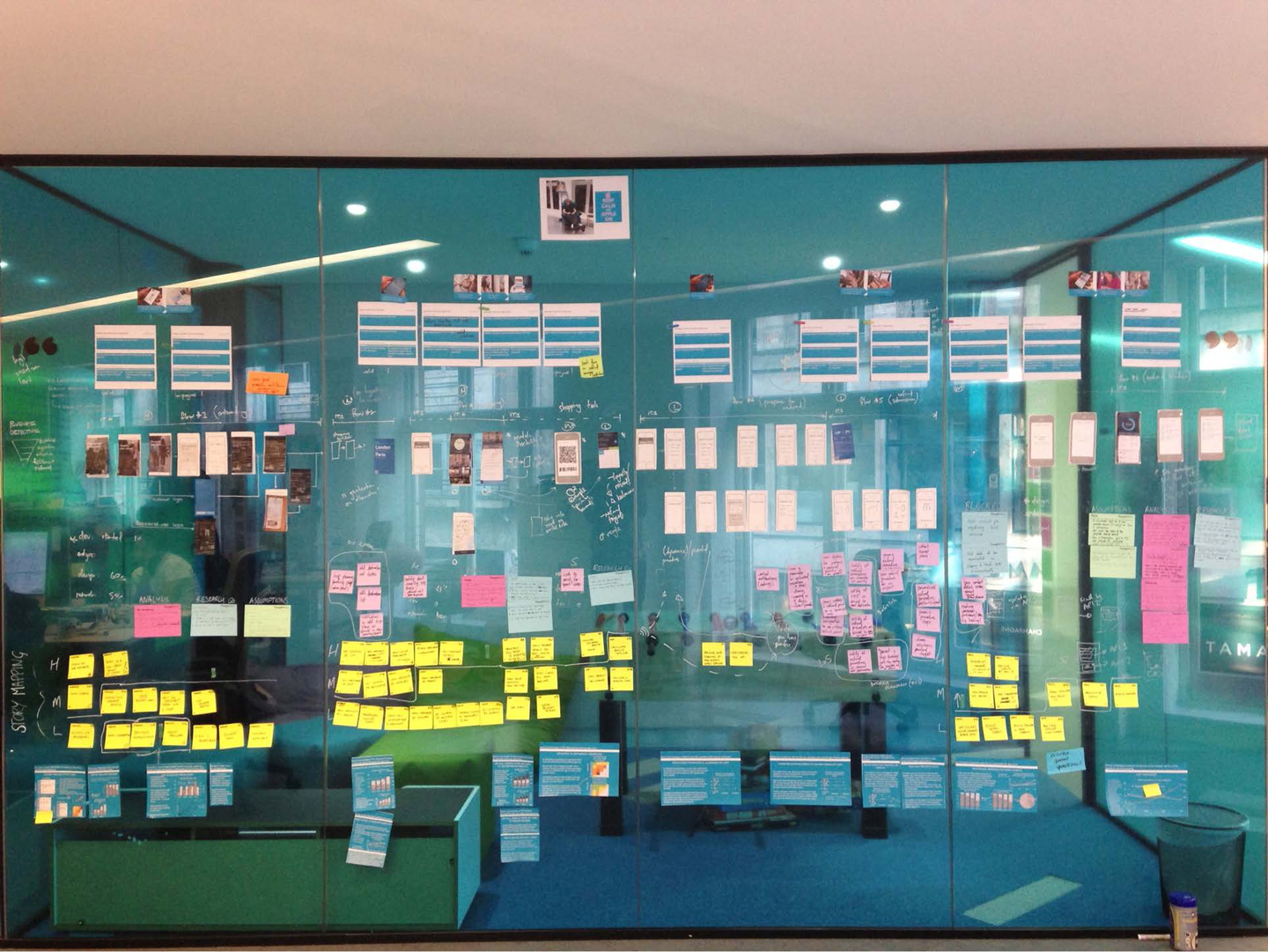
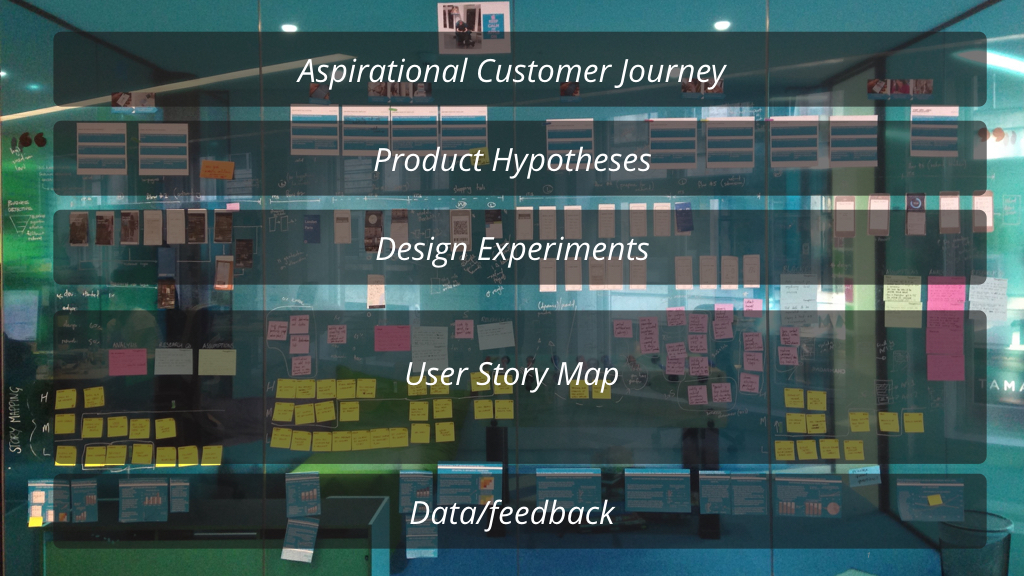
Figure 4-1. A product design wall
Techniques for Prioritizing Value
It’s an awesome thing to have a shared vision, an initial strategy about how you’re going to get there, and the right people and resources to make it happen. Teams now face three critical questions:
What shall we do first?
How will we know if it’s working?
What do we do next?
Simple as these questions sound, the answers aren’t always obvious or straight forward. Especially when there are many options and limited capacity to do them. Those conditions seem true for every product team ever; this problem is universal. There aren’t enough people—and never enough money—for organizations to do all the things they want. They must choose and decide. In our personal lives, we make decisions continuously about what our goals are and how we’ll spend our time and resources in pursuit of them. At the park, a thirsty puppy chooses between a slurp of water (biological needs) and playing with his pals (social needs) during his morning walk.
But acting on instinct is dangerous. Buster Benson, John Moonigan, and others highlight all the ways we let our biases get in the way. The themes they describe here don’t help us to make objective choices:
To get things done, we tend to complete things we’ve invested time and energy in.
To stay focused, we favor the immediate, relatable thing in front of us.
We simplify probabilities and numbers to make them easier to think about.
We favor simple-looking options and complete information over complex, ambiguous options.
Let’s look at some ways to make better decisions.
Dimensions of Success
To know that you’re being successful, you need to know what success looks like. The dimensions of success you define ought to have direct correlation with your vision and strategy. Ask specific questions. What ways might an activity contribute to a strategic outcome?
This kind of subjective reasoning can be useful for initial prioritization of what to do first. At this stage, our threshold of knowledge is often pretty low, mostly because meaningful action is yet to be taken. It’s okay to use our intuition—and any empirical data that’s available—to make initial judgments about the potential of a set of options to deliver on the desired outcome. Figure 4-2 shows an example of this.
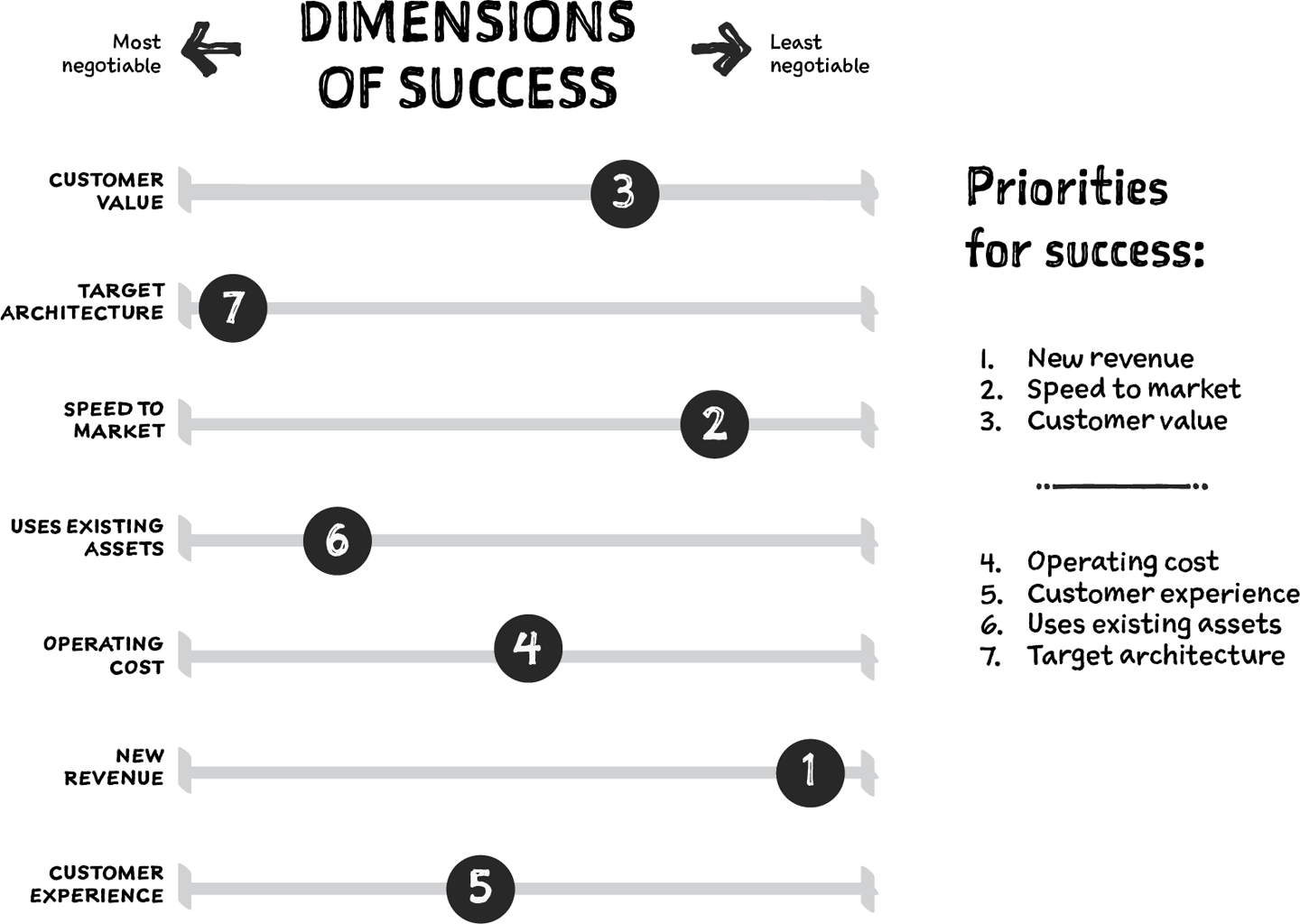
Figure 4-2. Dimensions of success for a digital team
Making Success Measurable
We measure things so that we can make better decisions, and measurement is the only way we can answer the question: is it working?
If a measurement matters at all, it is because it must have some conceivable effect on decisions and behavior. If we can’t identify a decision that could be affected by a proposed measurement and how it could change those decisions, then the measurement simply has no value.9
Douglas W. Hubbard
We need to consider how valuable a piece of information will be in the future. Will it help us to make decision? If we hit the number or reach a specific target, might we then stop further work because we’ve done enough? What if it moves the wrong way; what will that mean, and what might we do about it?
It’s not that we need to predict all potential possibilities or put in place a precise system of measures that automates our decisions. Rather, we need to think about the indicators that will be useful for making some sense or meaning. What can we observe, that will help in making decisions?
Suppose that you’re operating an online electronics business, selling everything, from $5 Arduino breadboard kits to high school students, to $50,000 control system components to avionics engineers. You want to make it the best experience possible for customers, and you believe from talking with them that easily finding what they’re looking for is the most important thing to them. You have a range of initiatives in play aimed at improving things for customers. What measurements will you take, and how will you use those to determine what’s occurring, and what to do about it? Table 4-2 illustrates how to break down goals into useful measures of success.
| Goal: customers can easily find what they are looking for | |
|---|---|
| Measurement | Comment |
| Customers will be delighted | Too vague |
| Net Promoter Score (NPS) will increase | Subject to external factors, difficult to attribute to a specific initiative |
| 10 customer features or initiatives completed | Measures output, not outcome |
| Conversion from results page to product detail page increases by three percent month-on-month | Good! |
| Basket-size for returning customers increases on average from quarter-to-quarter | Good! |
| Average time-on-site per transaction reduced by six percent quarter-to-quarter | Good! |
With a clear understanding of what success looks like and how it will be measured, now it’s time to choose initiatives that we believe are most likely to achieve the outcomes.
Value-Based Prioritization
The following prioritization techniques offer fast ways to compare initiatives relative to one another.
Relative prioritization using dimensions of success
Figure 4-3 shows relative prioritization using two dimensions of success for comparing initiatives.
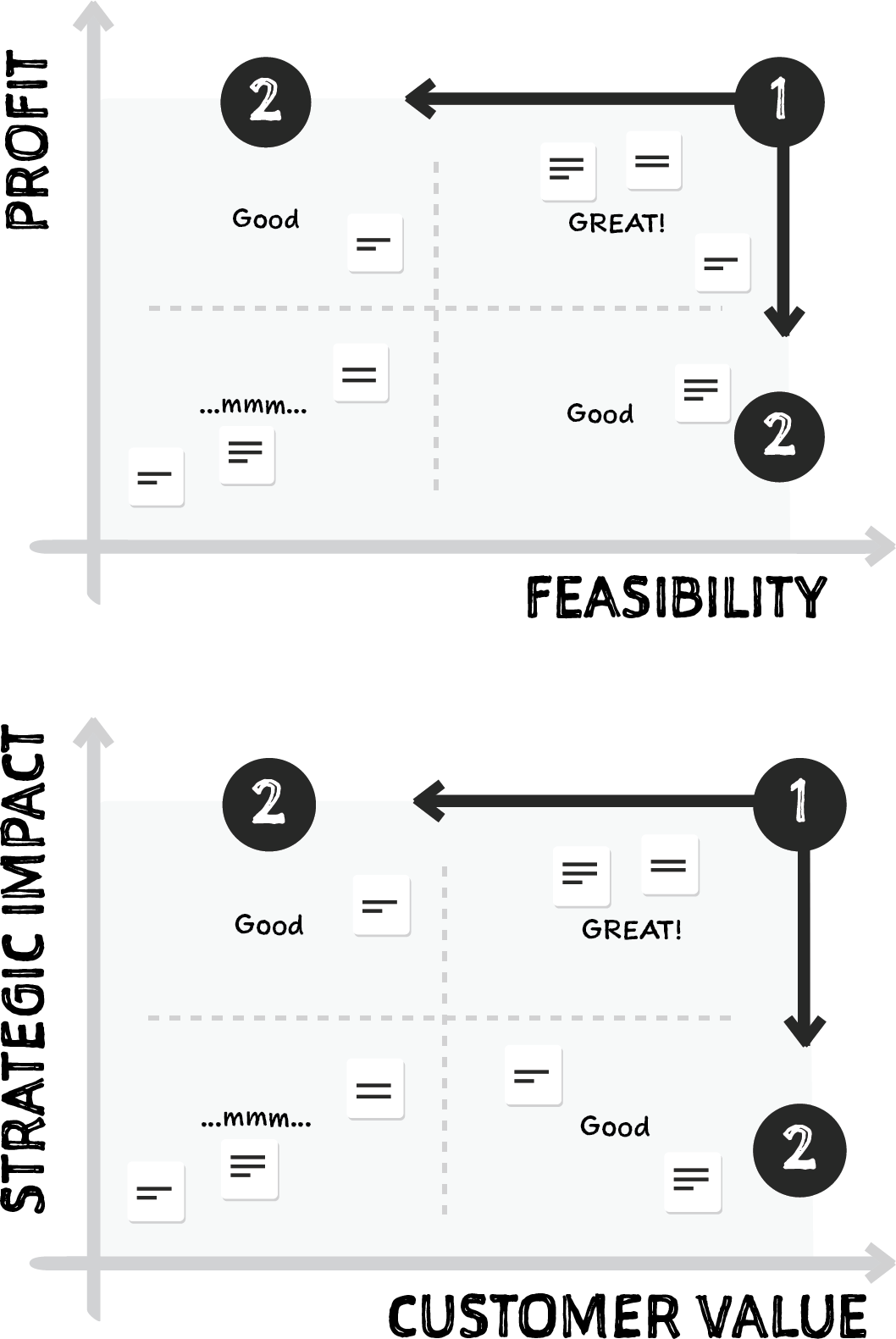
Figure 4-3. Relative prioritization using dimensions of success (source: ThoughtWorks EDGE Playbook)
You’re not restricted to using just two dimensions; it is just a common way to visualize competing concerns. In the case of the top diagram, initiatives are ranked relatively, according to their perceived ability to generate profit and the feasibility of implementation. In this case, the initiatives in the upper-right corner would be prioritized, because these have the highest profit potential and are the most feasible.
This kind of prioritization helps to reduce a large number of initiatives into a smaller set on which to focus.
Relative prioritization using weighted average
This prioritization framework uses a weighted average of the dimensions of success to identify the highest value initiatives.
By ranking and selecting the most important dimensions of success and then applying a weighting, we can calculate a relative value of all initiatives in a given collection.
Using our ranked dimensions (see Figure 4-2), let’s focus on the first three: new revenue, speed to market, and customer value.
Let’s assume that new revenue is the most important, with speed to market and customer value weighted the same, equating to 60, 20, and 20 percent weighting, respectively.
Now we can use the arithmetic in Table 4-3 to calculate the weighted average score for each candidate in a list of initiatives.
| (Rank1*Weight1 + Rank2*Weight2 +... +Rankn*Weightn) / # dimensions | ||||
|---|---|---|---|---|
| Ranked dimensions of success | ||||
| New revenue (60% weight) | Speed to market (20% weight) | Customer value (20% weight) | Weighted average (smaller is better) | |
| Initiative A | 1 | 1 | 3 | .47 |
| Initiative B | 2 | 3 | 1 | .67 |
| Initiative C | 3 | 2 | 2 | .87 |
A simple weighted average is derived by multiplying the rank by its weight for each initiative, and then dividing by the total number of dimensions being measured. A lower number is better overall, so Initiative A ranks the highest, Initiative B ranks next highest, and Initiative C is last.
Relative prioritization using CD3/WSJF
CD3 stands for Cost of Delay Divided by Duration. This method is also known as WSJF, meaning Weighted Shortest Job First. Cost of delay is about what an organization stands to lose until the work can be completed and value capitalized. For all intents and purposes, cost of delay is about business value and time for a given initiative.
This kind of prioritization is a hunt for the smallest, highest value initiatives. Small is critical. We know from Lean manufacturing and theory of queueing that small batch sizes are fundamental for optimizing flow.10 In product development, we make initiatives as small as we can while still having value. This reduces cycle time, allowing value to flow more continuously. Smaller chunks of work also equate to more flexibility because small commitments mean small losses if an initiative is failing or needs to be abandoned for some reason.11 This all makes diversification of investments or optionality12 easier to achieve.
So, we need to understand something about the relative size or duration of an initiative and its potential value. Then, we’re able to calculate a CD3 score and compare it with others to identify the smallest, highest value candidates.
Back to our example, Table 4-4 shows how CD3 is calculated.
| (Potential revenue + Time to market + Customer value) ÷ Duration | ||||||
|---|---|---|---|---|---|---|
| Ranking | ||||||
| Potential revenue | time-to-market | customer value | Cost of Delay (last 3 cols) | Job size estimate (effort) |
CD3 score (higher is better) |
|
| Initiative A | 1 | 1 | 3 | 5 | 1 | 5 |
| Initiative B | 2 | 3 | 1 | 6 | 0.5 | 12 |
| Initiative C | 3 | 2 | 2 | 7 | 3 | 2.33 |
In this case, Initiative B is ranked the highest. It has a moderate cost of delay, and a short estimated duration, meaning we can achieve value quickest by doing this work first. All of these prioritization techniques help us to select high-value work and get it done quickly. It’s not just about time, and it’s not just about value. How much we do (batch size), when we do it (sequence), and how much work is happening at the same time (concurrent work in progress) matters, too. Figure 4-4 shows how limiting work in progress, sequencing work, and reducing batch size can result in earlier realization of value, given the same constraints of time and effort.
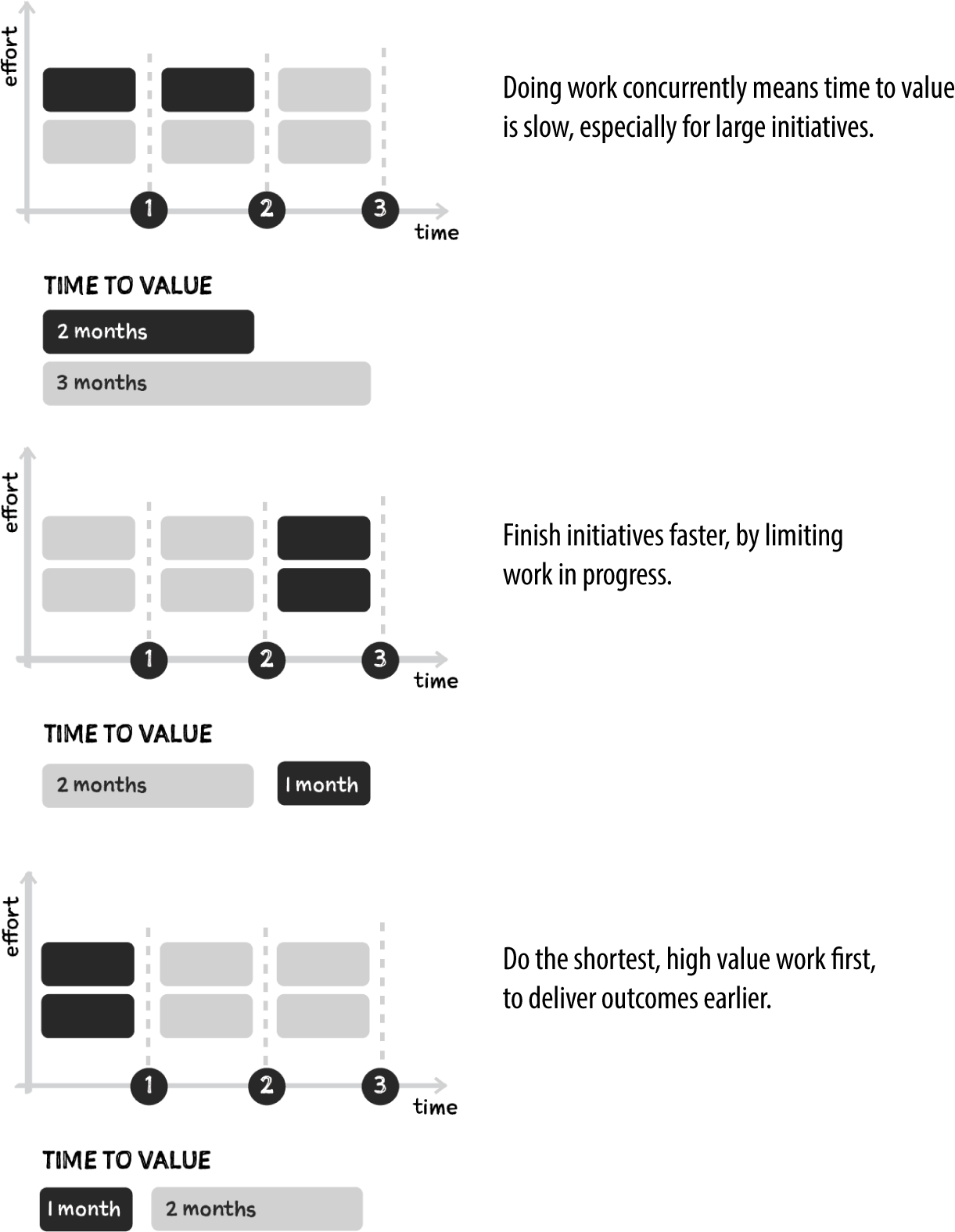
Figure 4-4. Two initiatives of different sizes can be sequenced to reduce time to value (source: Lean Enterprise13)
Conclusion
When people are empowered with true autonomy, and aligned to purposeful missions, they’re not only more motivated, but also able to overcome challenges and achieve outcomes in ever-changing situations. Mission command is a protocol for leading teams in this way, and it melds beautifully with scientific thinking and deliberate practice of the Lean mindset.
To do this well, clarity of purpose and an understanding of success and how it’s measured is paramount. Visual management techniques offer a variety of ways to align to purpose, whether it’s an entire organization, a portfolio of initiatives, or one product team on a mission.
Even though purpose gives direction, teams need to prioritize value and measure success to find their way. Measurements are the signposts of progress that we use to decide what to do next. This, along with value-based prioritization helps teams to maximize outcomes within the constraints of a given system.
Predominantly, it’s the Lean mindset influencing our decisions as to what to do, when, and how to adapt our strategy. The ever-adapting nature of Agile delivery plays a supporting role by being an enabler, not a constraint to change. Where Lean has scientific and critical thinking covered, Design Thinking provides the creativity needed when exploring new challenges, as the situation changes.
1 To me, a pencil factory is actually fascinating, along with many other surprisingly awesome things.
2 Carl Deal, Tia Lessin, and Michael Moore, Where to Invade Next. Directed by Michael Moore (2015).
3 On the contrary, I’ve found that people are mostly intelligent, helpful, and kind.
4 Daniel H. Pink, Drive: The Surprising Truth About What Motivates Us (Penguin, 2011).
5 Incentives work just fine for predictable, repetitive, procedural activities. The catch is that most work in modern businesses requires problem solving and creativity. This work suffers under incentives.
6 US Army, United States Government, Army Doctrine Reference Publication Adrp 6-0 Mission Command (2011).
7 Formatting (italics and parentheses) is my own.
8 James Kalbach, Mapping Experiences (O’Reilly, 2016).
9 Hubbard, Douglas W., How to Measure Anything: Finding the Value of Intangibles in Business (Wiley, 2014).
10 Donald G. Reinertsen, Principles of Product Development Flow (Celeritas Publishing, 2009).
11 This is especially helpful in combatting sunk cost fallacy, a common bias in which the cost of stopping is perceived to be too great, because so much has already been invested.
12 Jason Blum is one of the most profitable Hollywood producers today, and he doesn’t do it by making megabudget blockbusters. His studio, Blumhouse productions, exploits optionality by making many small bets on microbudget films and managing costs like a hawk. Some of those films succeed, and they’re some of the most profitable in the world. Tune into NPR’s Planet Money episode no. 650 to hear the full story on how Blumhouse has the smallest budgets but the highest profits in Hollywood.
13 Jez Humble, Joanne Molesky, and Barry O’Reilly, Lean Enterprise (O’Reilly, 2014).
Get Understanding Design Thinking, Lean, and Agile now with the O’Reilly learning platform.
O’Reilly members experience books, live events, courses curated by job role, and more from O’Reilly and nearly 200 top publishers.

